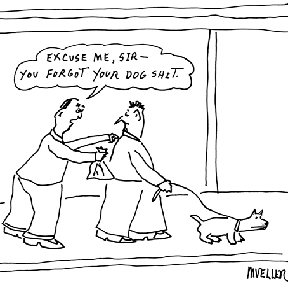1. Raw food can greatly reduce the risk of your dog developing health conditions of all kinds, ranging from simple diarrhea to the greatest risk to dogs after cancer - bloat (see the next entry for more info).
2. Raw food is often less expensive than kibble. You need to feed your dog more kibble to satisfy her/his dietary needs. Over the course of a week, a healthy adult dog needs to consume about 15% to 20% of their body weight. If your dog weighs 20 pounds, you can expect to feed her/him 3-4 lbs of food each week.
3. Raw bones act as a natural tooth-brush, and fortify teeth with calcium. Adults love a good RMB - Raw Meaty Bone.
HOW TO FEED YOUR DOG RAW FOOD:
* Make an arrangement with a good butcher or local farmer for your meat source. If you have some extra freezer space, you’ll can work out good deals buying in larger quantities.
* Spread newspaper beneath your dog's bowl, to keep any mess under control
* The general rule with raw foods is to feed a healthy adult dog between 2-4% of its weight daily, and then adjust as needed. Puppies should be fed 2-3% of their expected adult body weight; they may require up to 10% of their weight.
* Rotate your dog's diet: Some types of meat are higher in iron, others are higher in vitamin A.
- About 60% of their diet should be a rotation of chicken, turkey, beef, oxtail, rabbit, hen, quail and/or fish (canned sardines should be in water). You can feed them pretty much any part. In the beginning, introduce one protein source at a time. Feed chicken for a week, then beef for a week, and so on, to introduce these foods to your pet’s system, so as to easily detect any protein allergy.
- Your dog needs organ meat - 10% of their diet should be liver or kidney.
- Include vegetables, eggs, fruit, yogurt, etc. Eggs are a good source of calcium, good to use when you don’t have bones. Pumpkin is a good system regulator. (NOTE: No need for any grains. Commercial pet foods are grain-based, but dogs don't need grains - in fact they may be bad for them overall!)
* For maximum dental benefit and to minimize the possibility of choking on small pieces, give your dog whole lumps of RBM. Important: Cooked bones run the risk of splintering- NEVER feed cooked bones!
* Give puppies non-weight-bearing bones, as their young teeth can’t handle thicker bones.
* Be aware that dogs tend to become protective of their bones - discourage young children from approaching dogs that are eating. For that matter, stay away yourself!
(A note on bacteria: Canine digestive systems have some natural immunity to bacteria; they can handle the ecoli, etc. in raw meat without issue.)






No comments:
Post a Comment